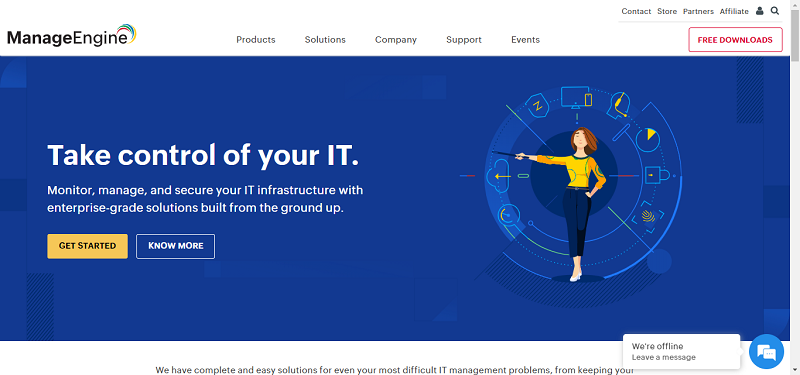Did you know that 50% of global corporate data is stored in the cloud? Little wonder many more businesses are working on moving their web-based applications to the cloud. A good reason for this decision is the high ROI on cloud-based apps. Companies make more money (usually through a subscription model) from in-cloud applications.
However, while this concept is brilliant and lucrative, it is more complex than it sounds. Transitioning from a web-based application to a cloud-based one is delicate when it comes to user experience design. UX design best practices have to be implemented to get the best of cloud computing.
This is where the function of UX in cloud development comes in. It makes the difference between a successful product and an unsuccessful one. By the end of this article, you will appreciate the role of UX in in-cloud development and be encouraged to invest in it.
UX stands for User Experience. User Experience involves all the steps or phases of a user’s interaction with your product. UX design is the process of creating a satisfying experience for the user. In this context, UX is short for UX design and is an integral part of product development.
To understand the function of UX in cloud computing, it is vital to understand the process of UX design. Design processes vary depending on the team and product. However, one thing all processes have in common is that they’re based on design thinking. The design thinking concept has five stages in it. They are discussed below.
At the Empathize stage, designers set out to understand the user and their problem. As a designer, it is tempting to assume you know all about the problem and proceed to design a solution based on your experience. This is a wrong approach and what the Empathize stage is about. The stage is all about understanding what the user is going through and what they need. Understanding what the user feels will help the designer create a great experience for the user.
After empathizing with the user, designers proceed to put together the information they have gathered. The pieces of information are collated, analyzed and synthesized. At the end of this level, designers are able to define the exact problem they’re trying to solve. These defined problems are called problem statements.
As the name implies, this is the phase where ideas are generated. With the knowledge derived from the first two steps, designers come up with ideas for solutions. A lot of activities are carried out at this stage to create ideas. The problem is viewed from different angles to determine the best solution.
This is the level where solutions are created. The best solutions to the problem statements are selected and the design team starts creating cheap or cost-effective versions of the product. Due to the back-and-forth nature of the design process, inexpensive materials are used to test the product at this stage.
Designers bring in actual users to test the prototype at the testing or validation level. This step lets the user use the prototype and give feedback on their experience. UX designers will then use the feedback users give to improve the product.
Note that the design stage is not linear; it is iterative. This means that designers can go back to earlier stages to refine, redefine and correct, all in the bid to create a better experience for the user.
To design the best experience for users, UX designers must be familiar with popular UX design tools. Standard user experience design tools include Maze, Figma, InVision, Sketch, Axure, Framer, Marvel, Webflow, FlowMapp. These tools are evolving daily and every designer worth their salt must be abreast of the trends.
Also known as cloud-based development or in-cloud development, cloud development is the process of creating software or applications that run entirely on the cloud. It enables more flexibility in developing and releasing new products. Building, testing, deploying, and operating software services in the cloud are all considered part of cloud development. Cloud software are programs created in a cloud setting.
Cloud-based and web-based products are similar but different. Find below the major differences.
UX designers must keep these principles in mind to design successfully for the cloud.
Seamless user flow is crucial for a good user experience, especially with a cloud-based application. Each action of the user should progress logically. Uphold this principle when designing to give your user an intuitive experience.
A complicated design will distract your user and make their journey difficult. Best practices for a good user experience include a straightforward and uncomplicated design.
The information architecture of the design for an in-cloud application should be easy to navigate and properly organized. This will allow the user to easily go from one part to the other.
Consistency is a time-tested design principle. It states that you should be consistent with using elements in your design. Lack of consistency leads to confusion and a less-satisfying user experience.
Users need to be able to load your pages faster. This is why you need to optimize your design for the cloud. When your pages load fast, it improves the crawl rate of your site, making the user experience enjoyable.
The functions of UX in cloud-based development are numerous. For example, mastering application dependency tools is great while transitioning to the cloud. However, it will be a wasted effort if UX design is not factored into migrating to the cloud or developing cloud-based products. Let’s touch on a couple of the functions of UX in in-cloud development.
The stage of empathy in user experience design facilitates understanding the user, which is one of the essential steps in product development. To develop a viable product, you must identify and understand your user. Cloud-based development won’t be successful without knowing the way the user feels about the product. UX design makes the user a priority in cloud-based development.
Good UX enables the user to navigate the product effectively. Smooth navigation is one of the ways a user has a great experience. Therefore, UX best practices like seamless navigation have to be utilized to develop a successful in-cloud product. The easier it is for your users to move from one place to the other on your app, the better their experience and the greater the chances of converting and retaining them.
In-cloud development is cost-intensive and companies must maximize cloud spending with good UX. User experience design involves a painstaking process that ensures that the final product is exactly what the user wants. The research stage of the UX design process lets the designers interact with users to know their needs and how to serve them.
In cases where UX was skipped in product development, there is always a price to pay. It’s the reason many businesses have to go back to the drawing board and redesign existing products. The UX design process saves money and time that would have been wasted if an unusable product is released into the market.
Great UX helps boost customer conversion and loyalty. When your users find your products usable and satisfying, they’re happy. Happy customers become loyal customers and brand ambassadors. This ultimately grows your brand.
Cloud computing and UX are a duo that has the potential to bring great value to your business by saving time and resources and growing your client base. Attempting cloud-based development without UX is akin to developing a failed product. The reason is that users are at the core of product development and a good product cant be created without them.
For UX to perform its cloud-based development function, certain principles must be followed. These principles include smooth user flow, uncomplicated design, strong information architecture (AI), consistency and design optimization.
Some functions of UX in in-cloud computing are understanding the user, easy navigation, time and cost-effectiveness and brand growth. When it comes to cloud-based development, UX should be given its flowers. Without it, product development is incomplete.
By Moyofade Ipadeola





